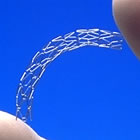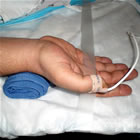
|
Angioplasty Without Surgical Backup
|
|
||||||||||||
|
Current Postings on This Page (31):
• Hi my hospital want to carry out an angiogram for diagnosis but cannot offer stenting. Should I risk this procedure twice?
• I live in an area where we only have internist working in the ER. We have no heart specials only internist. These professionals all have there own speciality lung etc. The nearest Heart Unit is 4 hours away by Ambulance or plane. I would like to know the time frame to stint [stent] a person. I know 90 minutes, but if 4 hours what damage is expected, 8 hours what is expected damage. I know it comes down to EKG issue but there must be some guide line (time frames). As the night of MI I was told by initial doctor that I am having a major heart attack. So what is required to ship of hospital. Also if stable should they not of shipped me as I could not take the thrombolytic Treatment due to bleeding in colon, and at this point there is nothing else they could do. • AM from Connecticut -- That's an excellent
question. We will look into this and post our research back to this topic. • any idea how many centers exist around
the country that offer angioplasty without open heart backup? Is there
a list
somewhere? • Wrig -- the
original study was called C-Port or Atlantic
C-Port and was instituted and run by Dr. Tom Aversano a
decade ago (Dr. Aversano contributed some of the original posts to this
Forum
Topic). A number of hospital systems have adopted some of its
methods, in close collaboration with their state medical boards, and
localities. The study did not "allow" groups of hospitals to
do pangioplasty without surgical backup, but studied those that did to
see what outcomes
were. One of the big advances in interventional cardiology was the introduction
of stents. The most common complication of angioplasty that required
surgical repair was a collapsed artery. Stents have made that complication
virtually
disappear. • What is the name of the current study on this question that is allowing
groups of hospitals to do angioplasty without open heart backup? Supposedly it
will have its data gathering done by May, 2011 and then publish within 18 months... • i am an interventional cardiologist in southern
california,we have a diagnostic lab and about 30min away an interventional
lab. we suddenly found that we had no standby in the entire county. would
any one place an elective patient on the table of cath, without any cardiothoracic
surgeon. the closest on being 3 hrs away at best. the local cardiothoracic
surgeons would not give any back up
due to lack of contract. • We have been doing primary angioplasty for 11
years at our community hospital in Massachusetts and have NEVER caused
a patient to need emergent bypass. We have sent pt's who need it immediately
for left main disease rarely and we place an intraortic balloon pump
and transfer without difficulty. We are now involved in the MASSCOMM
trial whereby we are doing elective angioplasty without surgery on site
(SOS).
I think the knowledge and skill of the entire team makes the difference,
not just the services of the hospital!!!!!! • It seems to me that the original topic question
needs to distinguish between emergency procedures, or PTCA to tackle advanced
occlusions. I have had two stent procedures, about 4 months apart. One
was an emergency procedure to treat an acute occlusion causing a massive
MI. The second was an elective procedure to treat a CTO detected during
the first. While the CTO was a candidate for PTCA/stenting, ultimately
the procedure failed during final inflation of the stent. I rapidly developed
tamponade from bleeding, and was rushed down the hall to surgery for an
emergency CABG. I just think it is important to be clear on limits and
boundaries as PTCA becomes ever more capable of dealing with ever more
difficult situations. In an emergency MI situation, it may well be that
having onsite PTCA capability outweighs the risk. But that does not mean
that non-emergency procedures should also be done. Given the cost of setting
up and running a cath lab, I'd worry that there would be administrative
pressure to expand the services offered to enhance cost recovery (especially
if the number of emergency cases was well below the lab's operating capacity),
possible at the expense of the best interests
of patients. • My mother has passed away while doing angioplasty
(left coranry artery). Cardiologist (Dr. Rajakantan, Sri Lanka) wanted
to do a emergency bypass, but they were not ready even couldn't find
a surgeon. My experience -- don't do this if you are not ready for an
emergency bypass. • I am a director of a diagnostic cath lab doing
aprox 400 cases a year. We have an open open heart facility 10 minutes
away. I would like to know if it would even be possible to do intervention
at our facility. What's my first step. The physicians and staff have all
done intervention elsewhere. I am getting tired of transfering patients
when we could have easily fixed their problem on our table. • Yes,You are doing excellent job. • I would call to everyone's attention the largest
study to date on this topic, just presented at today's American Heart Association
meeting. The results: there is no difference in the mortality rates from
emergency angioplasty at hospitals with or without surgical backup. The
article can be found here. • We started a primary PTCA program in Oct. 2000 & have
had excellent outcomes. We used the Exeter, NH model/PAMI-No SOS Trial.
CA state law allows only primary angioplasty without surgical backup, elective
currently must have backup. We set our program up in the form of a study,
with clear inclusion/exclusion parameters. We collect data on each case & do
regular case reviews. We built a very solid foundation which will expand
into a larger cardiac program. • I have been performing acute angioplasty asa first
line of treatment for acute mi for last 4 years.Recently we started this
program in a centre w/o sos. In last 1 year 21 cases have been done without
any in hospital mortality. We reffered one patient with LMC stenosis and
total LAD occlusion to nearby surgical centre.I strongly feel that acute
angioplasty can be performed without sos. • For those of you who are doing PTCA without backup,
where do you look for reimbursement - private or medicare? We would like
to start-up here in Florida - 1500 diagnostics per year with 4 MD's doing
PTCA at sister hospital 30 minutes away.... • In the opinion of my government, PTCA procedures
for interventional angioplasties cannot be performed in a medical center
without a cardiac surgery unit in stand-by • I would not want to be part of the percentage
of the people who do not have an hour to save my life if the PTCA fails.
I work in a hospital that offers PTCA as well as OHS and have seen many
emergency OHS (Open Heart Surgery) patients go to surgery. Thank goodness
we had surgery to save their lives. My question would be are we saving
a few bucks by not transfering these patients to a facility that can provide
OHS should it become necessary? I hope not. • I am a cardiologist in a rural setting and have
diagnostic cath without interventional due to our volume (500 diagnostics/yr).
I want our patients to get the best treatment and find that sometimes tPA
doesn't cut it and rescue or primary PTCA are less than ideal due to transport
time and because our referral University isn't quite geared up for it.
I now find myself wondering if it isn't time to set aside our standard
of CABG and PTCA in the same center. Stents and support devices do represent
a step forward and may tip the scales enough to change policy. I read this
forum with keen interest. I also note Osler's quote : "The greater the
dogmatism, the greater the ignorance." • Ohio has had strict Certificate Of Need (CON)
laws governing cath labs and requiring a Open Heart unit to do PTCA. I
was administrator at cath lab of 1400 case/yr & no O.H.; cardiologists
traveled 30 miles away to do PTCA (often at 9PM or later). We trained our
cath lab staff in PTCA support by rotations at hospital that was receiving
our referrals & started emergent PTCA program to save lives (sorry if that
sounds greedy). Before stents, we did 6-12 per year. First case was Chief
of Radiology who came to ER with AMI, was immediately taken to cath lab
(while transport was called), arrested on table, had PTCA done, and recovered
with no damage noted by ECG. State Dept. of Health reported us to Physician
Review Organization (PRO) for revocation of all Medicare funding. PRO reviewed
our charts & those of two other sites doing emergent PTCA and recommended
other high-volume, non O.H. sites in Ohio begin similar program TO SAVE
LIVES. The Dept. of Health buried the report and did nothing against the
hospital. The programs continue. • For our clinical trial, health care regulators
in both Maryland and Massachusetts granted waivers for this procedure.
It is clear that the pressure to perform primary angioplasty without on-site
cardiac surgery is growing: our trial gives the states a chance to study
the issue (imagine, evidence-based medicine) before deciding whether or
not to open the flood gates. It should also be noted that some states do
not have regulations which prohibit primary angioplasty at hospitals without
on-site cardiac surgery (eg. North Carolina). • My questions to the labs that currently perform
PTCA w/o surgical back up is how do you do this when your state license
is granted for only diagnositic procedures? • In our hospital, we do not have a cardiac surg
program. However in our cath lab (open 10 years), we have always done emergency
ptca. This is only done in a patient who has received thrombolytics and
who has not reperfused and is not doing well, or has a contraindication
to thrombolytics and who is not doing well. We feel especially since the
introduction of stents, that PTCA is safe and efficacious. We have cardiac
surg 30 min north and south of us. • We are conducting a clinical research project
which, in part, randomizes AMI patients between thrombolytic tx and primary
angioplasty at hospitals without on-site cardiac surgery. Anyone interested
in hearing more, please contact me via email or at 410-955-3996. • We perform approximately 11,000 procedures per
year with 6,000 being interventional. In 1996 less than 10 patients were
taken emergently for CABG (Thanks to the new "Stent" Attitude) If you are
located within reasonable distance of a CABG center with reliable air or
ground transport, I don't see a major deterent to your program. • I started a program such as you describe in 1982
in Indiana and again had to deal with emergency PTCA in totally occluded
vessels producing an acute MI while a surgical program was being established.
It is possible, desirable and feasible to do so. The emotional response
you see recorded when this idea is expressed ought to be ignored. Study
of the merits of the idea has not yet been done. It would require comparing
the outcome of 100-150 patients treated with emergency angoiplasty at your
facility to the outcome of 100-150 patients referred from your facility
for treatment. Such a study is likely to deteriorate into an argument on
the quality of the outcome you got in the patients referred out (someone
will argue the program you refer to gets substandard results. Research
results would only be applicable to your set of circumstances probably
. The additional time delay trying to refer patients out from a facility
with a cath lab can be expected to result in a penalty to morbidity and/or
mortality which outweighs any penalty imposed by lower case loads in your
lab. If your cardiologist is experienced and well trained, the patients
would benefit from angioplasty of totally occluded vessels causing an acute
MI right then. I would be happy to pass on the experiences I have had in
setting up a program such as you describe and I can pass on the names of
hospital administrators and a cath lab supervisor who helped me do it. • Emergency PTCA has gained world wide acceptance
and the number of cases that really need Emergent CABG are very rare. The
mortality of CABG in an AMI setting is very high. We perform 1000 procedures
per year and we actually do PTCA to almost all patients that come to our
center with an AMI. If a patient can not be "opened" we prefer not to operate
him on. We are not in the USA but if you have a Hospital with open heart
surgery at 20 or 30 minutes far, you can do it. Just let the ACC says the
last word. • Operators and hospitals working at that volume
of PTCA's should not be doing PTCA's let alone Emergency cases. All of
the current data supports this and only self serving rationalization and
greed can allow this. • I am a director of a lab , also in a Southern
state (USA), that performs approximately 700 cases per year. Of these 700
approximately 40% need some type of intervention! I would also like to
know if the the ACC is going to make a recommendation on this issue? Our
lab is located on the edge of a major metro area but draws many of our
patients from outside the metro area. Emergent PTCA would be very beneficial
to our patient population. • I am a supervisor of a cardiac cath lab in a Southern
state (USA) that is about to start an emergency PTCA program in our facility.
Our facility does not offer an open heart program, but our cardiologist
is trained in interventional cardiology and feels emergency PTCA should
be offered. Will the ACC take a positive stance on this issue, or simply
ignore the patients' needs in smaller communities? |
|||||||||||||






